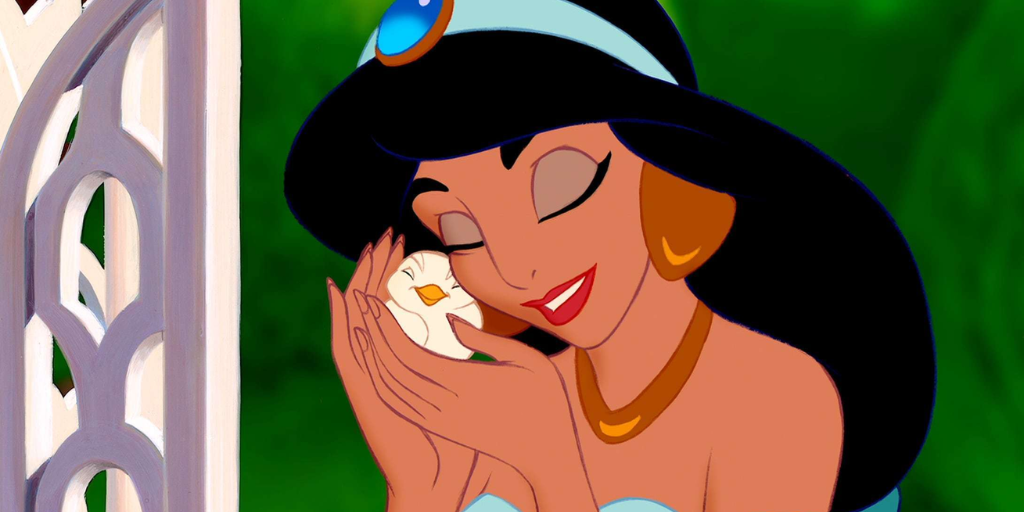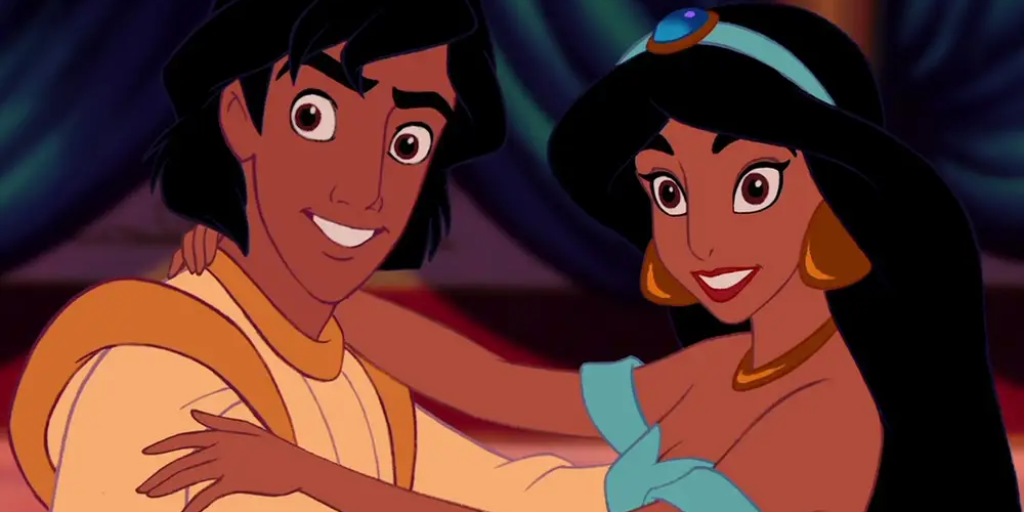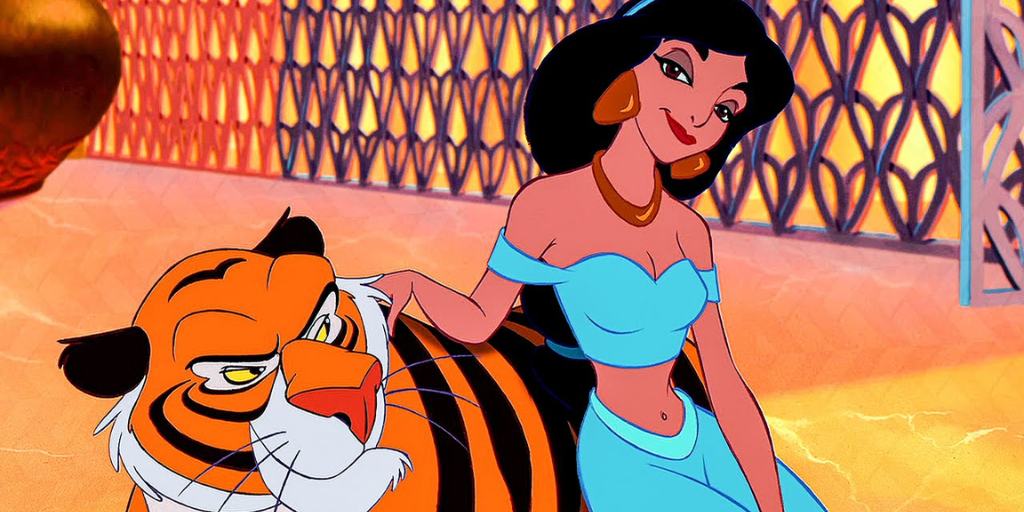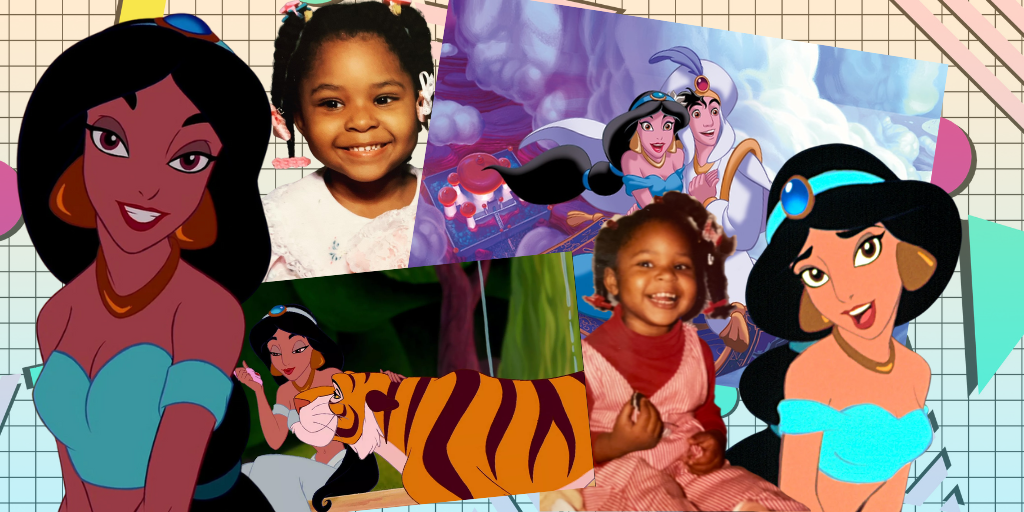My childhood was marked by fulfilling a childhood dream of becoming my favorite Disney Princess at the time, Princess Jasmine. (Disney/personal photos)
During 1992, the year Aladdin came out, I, like many other girls across the nation, became obsessed with Princess Jasmine. And, of course, like many girls, I dressed as Jasmine for Halloween, fulfilling a desire to feel like a princess for a night.
That memory had been buried for a long time until just a few days ago. Unfortunately, I don’t know where any pictures of me in my Princess Jasmine costume might be–out of the plethora of family pictures we have, I can’t find any from any Halloween time except for the recent pictures I’ve taken in my adulthood. But now that I’ve re-awakened to that moment in my life, I can remember the plastic smell of that polyester costume, the feeling of holding a bag of candy my parents would pick through to make sure it was safe to eat (with the result being me ending up eating candy we already had at home instead), and marveling at the novelty of candy cigarettes. (The fact that candy cigarettes were still popular shows just how times have changed–nowadays, you couldn’t even fathom giving a child a sugar stick designed to mock a carcinoginic product.)
Overall, it’s a great memory, but it’s one that is laced with a sadness that frayed the margins, even as the moment was happening in real time in 1992. Back then, there was no Princess Tiana. There was not even a hint of a Black Disney princess coming to theaters and it would still be a few years until Brandy graced our television screens as the first Black Cinderella. In a sea of princesses including the OG Cinderella, Snow White, Ariel, and Sleeping Beauty, Jasmine was the first of her kind. She was the only non-white princess Disney had, and for a little Black girl like me, that meant something. She might have not been my same race, but she, like me, was different.
Back in the early ’90s, finding Black girl characters on TV or in film was quite hard. It wouldn’t be until the mid-’90s through the early ’00s that I would begin to see many more Black female characters in media, thanks to the Black renaissance of film and TV–shows like Family Matters and Sister, Sister, Living Single and The Fresh Prince of Bel-Air, The Parent ‘Hood and Hanging with Mr. Cooper, Moesha and The Parkers, the list goes on and on.
But that list didn’t exist in 1992, so apart from Lisa Turtle (Lark Voorhies) from Saved by the Bell, Gaia from Captain Planet and the Planeteers and Guinan from Star Trek: The Next Generation (both played by Whoopi Goldberg), I gravitated towards the non-white female characters on my favorite shows at the time–Trini Kwan, the Yellow Ranger (Thuy Trang) from Mighty Morphin’ Power Rangers, Tina Nguyen (Tram-Anh Tran) and Gaby Fernández (Mayteana Morales) from Ghostwriter, and once Aladdin hit the scene, Jasmine became the new addition to the list.

When I watched Jasmine onscreen, I felt like there was a character in animation–my favorite medium–who could be my friend or, even more personally, an archetype for who I’d love to have as an older sister–someone who was effortlessly beautiful, proud, and is not ashamed to proclaim her worth (and, of course, she had an awesome tiger as a pet!). Jasmine’s outspokenness regarding her personal value as a human being might be the most underrated, but most powerful aspect of her character, especially for kids of color.
Too often, we are given overt and subversive messages about reducing ourselves to fit in, or to not be too loud, too excited, too joyful, or else the world will stamp it out of us. These messages are particularly drilled into girls of color–not only must we be quiet and mannerable in order to be seen as worthy, but we also get the added layer of being seen as unruly, “fast,” or older than we actually are just because of our race and our bodies. We are already cast as adults worthy of punishment, even though we are children who are innocently experiencing the world just as any other child would.
Even with Jasmine’s strength, though, her characterization still lent itself to the social mores of the time. Jasmine was willowy thin with an impossible waist, much like Ariel, who had debuted in The Little Mermaid a few years prior. Also like Ariel, she had a waterfall of long, beautiful hair. As a doll, this hair was great for brushing, but as a beauty standard, it could leave much to be desired. Was her hair beautiful because it actually was, or did we assume it was beautiful just because it was long? Same for her body–she was a pretty character, but did her desirability come solely from her narrow waist and tiny limbs?

Jasmine’s beauty reflected ideas that still haven’t died–that to be entirely feminine, desirable and attractive, you must have long hair, a thin body, big doe eyes, and a dainty frame. In fact, nearly all of the Disney princesses look like this, save for Moana and Pocahontas, who have more athletic builds (but the long hair still remains). Back in the ’90s, there was no such thing as a “plus sized movement” or “body positivity.” Body-shaming was very much in play. In fact, any differentiation was shamed–just take a look at how the nerds of the ’80s and ’90s were often portrayed as wearing glasses, being short or gangly, and, heaven forbid, smart. They were also often the butt of jokes, including jokes about if the popular girls in school would date them.
My intelligence was already something my parents rewarded me for, so I already knew I was smart. But, after seeing how intelligence was portrayed in the media, I quickly came to believe that I must fall into that “unattractive” camp just because I liked reading and writing. I wasn’t a girly-girl either; didn’t consider myself willowy or dainty or popular. Despite Jasmine’s forthrightness, she still fit into the “girly-girl” aesthetic. Could I truly be like her? I wasn’t sure.
There’s also the issue of just how Jasmine was the most sexualized princess out of the all of the Disney princesses. As I got older, I began to investigate more about the messages included in Aladdin. While the film is entertaining, it’s a classic that shows its age in terms of cultural sensitivity. Women featured in the film are routinely sexualized–just take a look at the dancers in the “Friend Like Me” segment:
And, despite how iconic Jasmine’s red costume has become, it is an outfit that carries baggage. Jafar dresses her in this outfit as a power move, to show that she is nothing more than an attractive object in his quest for power. However, Jafar himself is now seen as a negative stereotype of Middle Eastern men, and the film’s decision to make him force Jasmine into a hypersexual role doubles down on the harm the film causes.
The new film is way more respectful in how it approaches the Middle East and Middle Eastern characters. But, despite her flaws in the ’90s, OG Jasmine was meaningful representation at the time. For many, she was the only representation they had. At least I could point to Lisa Turtle; who could girls from Middle Eastern backgrounds point to? Unfortunately, Jasmine is still the only Middle Eastern character in the Disney Princess lineup 30 years after her initial film debut. Clearly, still more work needs to be done.

Until that work is complete, Jasmine will continue bearing the load of the aspirations, hopes and dreams young people of color have when they watch her. As for me, Jasmine helped me entertain the notion that I could perhaps see myself as a princess, as someone who was more than worthy enough to exist in the world as I am.
